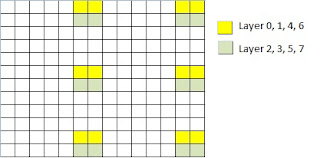In LTE, due to orthogonal nature of OFDM
signal, there is no intra cell interference. However, as the signal coming from
different cells is not orthogonal in nature, cell edge user may experience
interference from adjacent cell. LTE uses frequency reuse of one, meaning
adjacent cells may transmit
on same frequency, resulting in inter-cell interference.
Inter-cell Interference Coordination (ICIC) is the method used
in LTE to manage the interference arising due to signal coming from adjacent
cell sites. The basic principle is to coordinate the scheduling of cell edge
user in a way that users are not scheduled on same frequency time resources as
users in other cell.
The coordination between cell sites is
achieved by exchanging messages between eNodeBs over X2 interface. Two messages
are defined for uplink interference coordination: High Interference Indicator
(HII) and overload indication (OI).
High Interference Indicator HII)
is used to communicate, on which frequency time resources and eNodeB is going
to schedule cell edge users. By listening to this message, a neighbor eNodeB
can avoid scheduling cell edge users in the indicated resources. This can,
therefore, result in reduced uplink interference for both of the cells. The
action to be taken by an eNodeB when it receives HII message is implementation
specific.
An eNodeB send Overload Indicator message
to indicate the level of interference experience in different frequency time
resources to neighbor eNodeB. Three levels of interference are defined : Low,
Mid and High. When an eNodeB receives overload indicator message, it can change
the scheduling pattern to free the resources indicated in the overload
indicator message, therefore, reducing the interference for cell edge users.
In the downlink, interference coordination
can be achieved by controlling the downlink cell power for resources. This is achieved by sending Relative
Narrowband Transmit Power (RNTP) message. This message contains information
whether or not the frequency time resource is limited by transmit power. When a neighbor eNodeB listens
to this message, it can avoid scheduling on the indicated resources.
